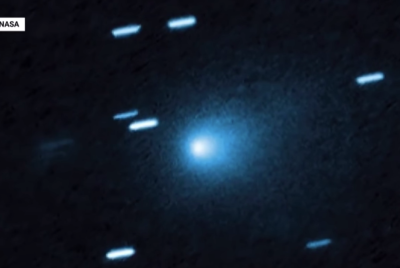Alien ship or interstellar iceberg? Why 3I/ATLAS is NOT the ET probe the internet hoped for

When astronomers first spotted the fast-moving object 3I/ATLAS hurtling through the solar system in July 2025, speculation erupted online: was it another ʻOumuamua—or even an alien craft?
Months of data from NASA, JWST, and global observatories now provide a clear answer. 3I/ATLAS is indeed interstellar, but it's not extraterrestrial technology—it's a naturally formed, billion-year-old comet from another star system.
Discovery That Sparked Alien Speculation
The Asteroid Terrestrial-impact Last Alert System (ATLAS) in Chile first detected 3I/ATLAS racing across the sky at extraordinary speed.
NASA Science later confirmed its hyperbolic trajectory, proving it was unbound to the Sun and would leave the solar system after its fly-through—making it only the third confirmed interstellar object after1I/ʻOumuamua and 2I/Borisov.
Almost immediately, Harvard astrophysicist Avi Loeb suggested that its unusual motion and brightness could hint at artificial propulsion. The idea spread quickly across social media, echoing his earlier claims about ʻOumuamua. But as new data arrived, that theory began to unravel.
Evidence Points To Natural Origins
The first breakthrough came from the MeerKAT Radio Telescope in South Africa. Scientists detected radio emissions consistent with cometary outgassing, not engineered transmissions, as reported by LiveScience.
Subsequent James Webb Space Telescope observations revealed an unusually high carbon-dioxide to water ratio (CO₂/H₂O ≈ 8 ± 1)—among the highest recorded in any comet. This ratio, astronomers say, reflects the extreme environment in which it formed, not alien machinery.
Further analysis using polarimetric imaging found a 'deep negative polarisation branch'—a scattering pattern unseen in ordinary asteroids but consistent with fine, porous dust from interstellar comets.
Even rumours of a post-perihelion explosion were dismissed; LiveScience confirmed the object remained intact. These findings collectively closed the door on the 'alien probe' narrative.
Why The Alien Theory Took Off
Experts say the fascination was inevitable. With only three known interstellar visitors ever recorded, the cosmic rarity alone fuelled public imagination.
Anomalous-looking features—such as faint acceleration, odd tail direction, and slowly fading brightness—added to the intrigue.
As Newsweek noted, social media's appetite for extraterrestrial mystery amplified every ambiguous observation. Yet, each anomaly found a natural explanation once more data became available.
A Relic Older Than The Solar System
Far from disappointing, the real story of 3I/ATLAS is even more compelling.
According to arXiv analyses, its surface is coated by a 15–20 metre-thick crust formed by billions of years of cosmic-ray exposure—potentially making it 7 billion years old, predating our own Sun.
Its extreme CO₂ content suggests it originated near the CO₂ ice-line of a distant protoplanetary disk or endured long-term radiation in interstellar space.
For astronomers, 3I/ATLAS offers a rare glimpse into material forged under alien stellar conditions—a frozen sample of another world, not a visiting spacecraft.
Lessons From The Latest Interstellar Visitor
Scientists say 3I/ATLAS proves that the scientific process—not speculation—unveils cosmic truth.
Each new observation has transformed initial wonder into a deeper understanding of how planetary systems form beyond our own.
It reminds skywatchers that nature itself can be as strange and wondrous as any imagined alien technology.
In the end, 3I/ATLAS is no probe—it's a natural interstellar iceberg, silently carrying the history of another star system through our skies.
© Copyright IBTimes 2025. All rights reserved.





















